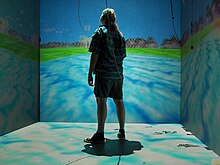

The Electronic Visualization Laboratory (EVL) is an interdisciplinary research lab and graduate studies program at the University of Illinois at Chicago, bringing together faculty, students and staff primarily from the Art and Computer Science departments of UIC. The primary areas of research are in computer graphics, visualization, virtual and augmented reality, advanced networking, and media art. Graduates of EVL either earn a Masters or Doctoral degree in Computer Science.
EVL represents one of the oldest art and engineering collaborations in the United States. It was founded in 1973 by Tom DeFanti (then of the UIC Chemistry Department, later Computer Science) and Dan Sandin (of the Art Department). The lab was originally known as the Circle Graphics Habitat, in reference to the then-name of UIC, the University of Illinois at Chicago Circle. DeFanti and Sandin served as Co-Directors of the lab, joined by Maxine D. Brown as Associate Director 1987. In 2001, Sandin retired from teaching, but continued to co-direct the lab with DeFanti until his retirement in 2004. EVL PhD graduate, Jason Leigh took the helm from 2004 through 2014, after which Brown became EVL Director joined by longtime collaborator and computer science professor Andrew Johnson as Director of Research.


Work at EVL over the years has included:
Highlights of the electronic art work done at EVL include:
EVL was featured in the Chicago New Media 1973-1992 exhibition centering the artwork that was created with the EVL and a demonstration of CAVE 2 was held during the time of the exhibition.[5] The exhibition was held at UIC's gallery 400, and curated by Jon Cates.[6]
The members of EVL have been involved with the SIGGRAPH organization and conference ever since its inception. DeFanti has served as Secretary (1977-1981) and Chair (1981-1985) of the organization, and 1979 conference chair. Brown has served as Vice Chair for Operations (1985-1987) and Secretary (1981-1985), and chaired the 1992 conference. According to Jim Blinn, the popular Electronic Theatre "started out as a bunch of people crowding into Dan Sandin’s dorm room to watch videotapes."[7] In 1979, DeFanti established the SIGGRAPH Video Review, which has been edited and administered by EVLer Dana Plepys since the mid '80s to present. At SIGGRAPH '92, EVL organized the "Showcase" event, where researchers demonstrated 35 projects in state-of-the-art computational science and scientific visualization. At SIGGRAPH '94, EVL organized the VROOM event, demonstrations of the state of virtual reality technology.
In 1998, Brown received the first ever SIGGRAPH Outstanding Service Award for her contributions to the organization. In 2000, DeFanti and EVL alumna Copper Giloth also received the Outstanding Service Award.
{{cite journal}}: CS1 maint: multiple names: authors list (link)
{{cite book}}: CS1 maint: multiple names: authors list (link)